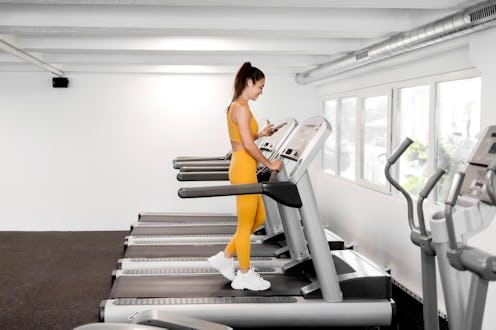Fitness
How To Walk On A Treadmill Incline In Perfect Form
Get the most out of that 12-3-30 workout.

Bump up the incline on your treadmill to do a 12-3-30 workout or an uphill climb and you might find yourself reaching for the handrails so that you don’t fall off the back. While it may feel like it’s assisting you as you ascend, holding onto the treadmill can mess with your form and make your workout less beneficial.
Note that it’s super common to hold the handrails on a tread, especially once you reach a grade of 10% or higher, says Emily Nichols, a certified personal trainer and Orangetheory coach. This is especially true if you’re trying an incline treadmill workout for the first time, she tells Bustle, since they’re extra tough and can leave you feeling wobbly, off balance, or more fatigued than usual.
The thing is, holding onto the handrails takes the focus off your legs and glutes, which are supposed to be doing all the work. “Walking on an incline is a great challenge for the lower body, it increases your strength and endurance, and raises that heart rate,” Nichols says. Using your arms for support or stability takes your legs out of the equation. It can also cause you to roll your shoulders forward, she says, which can lead to tension or pain in your lower back.
What’s more, holding on and leaning back means you’re working your hamstrings to pull yourself up the tread instead of using your glutes to push off the way you would naturally when climbing a hill, says Dave Candy, PT, DPT, a physical therapist and owner of More 4 Life. That said, even if you don’t reach for the handrails, it can still be tough to figure out how to walk properly on an incline.
Luckily there are a few quick adjustments that make all the difference. Here, experts explain how to properly walk on an incline so you can get the most out of that treadmill strut.
How To Walk On A Treadmill Incline
Choose Your Incline
To get your body used to walking on an incline without holding on, set the treadmill to an incline that you’re able to walk on without using your hands, Candy says. It should feel challenging but not to a level that makes you feel unsteady. If you want to reach for the handrails, that’s a sign to lower the incline and speed to something more comfortable.
Stay Vertical
As you climb, aim to keep your body vertical to the ground or slightly leaned forward into the treadmill, Candy says — not leaning back. Use your glutes and calves to propel yourself forward uphill. You should feel a burn down your posterior chain.
Pump Your Arms
As you walk, “drive your knees up to help you climb the incline while pumping your arms at the same time to give you momentum to get up that hill,” Nichols says. It’s also recommended to keep your knees soft and your shoulders rolled back.
Keep Your Head Up
Nichols says that it’s common to put your head down when walking up an incline, which is something you’ll want to avoid. “That can block your airway when you want as much oxygen coming into those lungs as possible, in addition to straining the back of the neck,” she explains. “Keep your chin up to open your airway and control your breathing with each step up that incline.”
Lower The Intensity
Remember: If you can't do the incline without hanging on, lower the speed and/or incline until you feel comfy enough to take it up a notch. “Additionally, work out at an intensity no greater than a seven on a scale of zero to 10, where zero is resting and 10 is so difficult that you have to stop,” Candy says. That way you’ll get a great workout without overdoing it.
Studies referenced:
Haggerty, M. (2014). The influence of incline walking on joint mechanics. Gait Posture. doi: 10.1016/j.gaitpost.2013.12.027.
Silder, A. (2012). Predicting the Metabolic Cost of Incline Walking from Muscle Activity and Walking Mechanics. Journal of biomechanics, 45(10), 1842. https://doi.org/10.1016/j.jbiomech.2012.03.032
Sources:
Emily Nichols, certified personal trainer, Orangetheory coach
Dr. Dave Candy, physical therapist, owner of More 4 Life
This article was originally published on